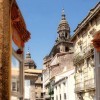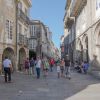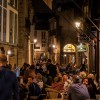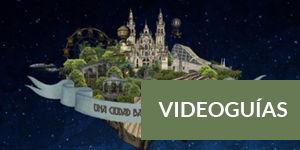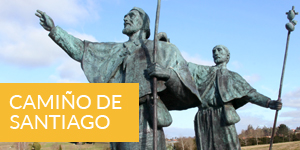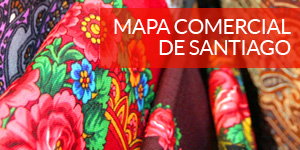- Accede I
- Regístrate I
- carrito
1 día en Santiago
MAÑANA
Lo primero es recorrer las rúas y plazas del casco histórico para después entrar en la Catedral. Para guiarte en esta tarea, en las oficinas de Turismo de Santiago puedes hacerte con el plano-guía oficial de la ciudad –propone una ruta a seguir e indica la situación de los monumentos que salen al paso-, solicitar el folleto detallado -facilita información pormenorizada sobre la ruta anterior-, alquilar una audioguía, o apuntarte a una de las visitas guiadas.
Una vez en la basílica, no puedes perder la oportunidad de visitar el Pórtico de la Gloria, o las cubiertas de la Catedral, desde donde se ven todos los tejados de la ciudad y se aprecia en todo su esplendor la monumentalidad de Santiago de Compostela.
COMER
No podían faltar las típicas raciones gallegas, que son además lo suficientemente ligeras y rápidas, y eso nos permitirá sacar el máximo provecho de la tarde.
Imprescindibles son el pulpo “á feira”, la empanada –de bacalao, zamburiñas, “raxo”, atún...-, las navajas, mejillones, berberechos, o sardinas y “xoubas”, si estamos en temporada, o “zorza”, lacón, carne “ao caldeiro”, y por supuesto pimientos de Padrón, también en temporada, siempre acompañados de vinos gallegos y de tarta de Santiago en el postre.
Si prefieres platos más elaborados, recuerda que no puedes irte de Galicia sin probar sus productos frescos del mar en las preparaciones tradicionales: los pescados en “caldeirada” o con ajada, y los mariscos al vapor o a la parrilla. Dónde comer
TARDE
A primera hora de la tarde nos dirigimos a la Cidade da Cultura de Galicia (CdC). No podemos perdernos su magnífica y singular arquitectura, obra del neoyorquino Peter Eisenman. Además, la Cidade da Cultura de Galicia programa interesantes exposiciones temporales y actividades culturales a tener muy en cuenta.
De vuelta en la zona histórica, después del obligado shopping, sugerimos un paseo hacia los principales parques y jardines que ofrecen vistas panorámicas de la zona monumental: San Domingos de Bonaval y la Alameda. El de Bonaval cuenta además con dos interesantes museos.
Se recomienda visitar primero este último, debido al horario de los museos. Allí está el principal museo etnográfico de Galicia, el Museo do Pobo Galego, alojado en las salas del antiguo convento de San Domingos de Bonaval, del que podremos ver, además, la preciosa iglesia gótica y la fantástica escalera barroca de espiral triple, un alarde arquitectónico digno de un genio: Domingo de Andrade.
También en Bonaval está el museo CGAC -Centro Gallego de Arte Contemporáneo-, notable tanto por su contenido como por el contenedor, diseñado por el arquitecto portugués de renombre internacional Álvaro Siza.
Ambos museos tienen en común el parque de San Domingos de Bonaval, que ocupa la que fue finca conventual. Exquisitamente rehabilitado por el mismo arquitecto, proporciona perspectivas fotográficas únicas del Santiago histórico.
En el céntrico parque da Alameda, el más señorial y querido de la ciudad, hay varios monumentos, entre ellos dos iglesias, y es además el mirador privilegiado de toda la zona histórica, desde donde hacer la mejor foto frontal de la Catedral sobresaliendo en el horizonte, especialmente al anochecer, antes de cenar.
CENAR
Cocina de autor en los restaurantes de la nueva gastronomía gallega de la ciudad, entre los que hay algunos de diseño, con una gran calidad espacial, basada en la combinación de las últimas tendencias en interiorismo con la atmósfera atemporal que irradia del granito de los muros. Dónde comer
NOCHE
No experimentar la noche de Santiago es impensable. Recomendación para la primera velada: una copa tranquila en alguno de los pubs clásicos compostelanos, por supuesto. Salir de noche









